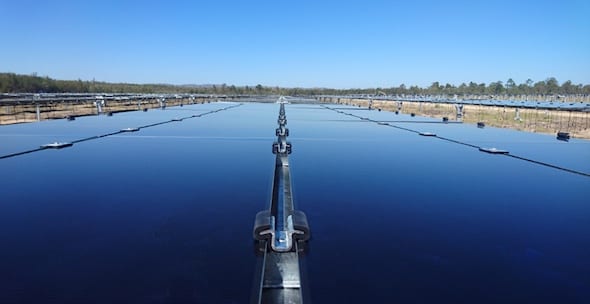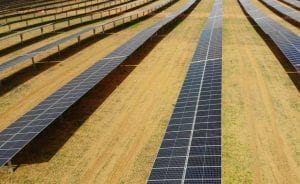 The first stage of Genex Power’s world-leading Kidston solar and the “giant water battery” project is set to begin sending electricity to the grid in northern Queensland, as the initial 50MW PV array powers up.
The first stage of Genex Power’s world-leading Kidston solar and the “giant water battery” project is set to begin sending electricity to the grid in northern Queensland, as the initial 50MW PV array powers up.
Genex executive director Simon Kidston said on Monday that the massive solar and pumped hydro storage project was on target to reach its next key milestone, the first export of electricity, in the next week to 10 days.
It’s an important moment for an important project; one which is essentially transforming what was once Australia’s largest gold mine into what will likely be Queensland’s biggest power plant – at least for a time.
Stage two will add another 270MW of solar PV and pumped hydro energy storage capacity of 2000MWh by the time it is completed, in early 2021.
Speaking at the Large Scale Solar and Storage conference, co-hosted by RenewEconomy in Sydney on Monday, Kinston (no relation to the owners of the original gold mine where it is sited) said delivering energy to the market was a “massive milestone” for the project.
“We are very excited that we’ve managed to get these projects to a point where they are bankable in a very, very short period of time… since company’s formation,” Kidston told the conference.
“But the real focus is executing a strategy for Stage 2, and I believe that though the support of our funding partners, that’s a very realistic target to achieve.”
Indeed, as we reported last week, Kidston Stage 2 (K2) is in line to reach financial close in 2018, after receiving another $5 million in grant funding from the Australian Renewable Energy Agency.
Kidston said the project had key economic advantages, including its location on an old gold mine – where old pits were re-purposed as reservoirs – and in Queensland’s PV “red zone”, where some of the best solar resource can be harnessed.
“Using the old gold mine provided an enormous advantage” in the mitigation of capital costs, he said, with two reservoirs for hydro, a transmission line on site, an air strip on site, and accommodation on site.
Water security was also a fundamental issue financiers would look closely at, he said – the mine site already had a pipeline connected to dam nearby, as well as a water entitlement.
That, along with the site’s existing environmental authority, helped make permitting very easy, he said.
Kidston, who credits Genex co-founder Michael Addison with the idea of using the former gold mine, said the company had built its business case around the premise that Australia’s increasingly renewables powered grid needs ways to store power.
“I guess we see the project as a giant water battery,” he said.
“The grid needs ways to store power. Whether that’s battery storage or pumped hydro energy storage, it doesn’t really matter, provided the intermittency can be managed.”
But the business case for Kidston was also built around soaring gas prices.
“Our hydro project, I guess at its heart, is not just a water battery, it’s also a peak power generator,” he said.
“We did the economics of our project when gas was trading at $2-$3 a gigajoule. With the gas price at $8-$10 a gigajoule, we believe that provides a compelling, sustainable advantage for the project.”
Crucially, it has also secured a 20-year old off take deal with the Queensland government, and a 30-year grid connection agreement with network operator, Ergon, which matches the expected life of the plant.
Kidston said Genex had also been careful to partner with tier one companies to develop the project, including US PV heavyweight First Solar and German-based inverter giant SMA.
And while project is a ground-breaking one for Australia, Kidston says he believes there is potential for as many as 10 more, at similarly ideally suited former mining sites around the country.
“There are a good half dozen half dozen sites …at least 5-10 sites around Australia that would be suitable,” he told the conference, while stressing that developing those sites would be no easy task.
“Never underestimate how hard it is to deliver a project in this country,” he said – “that’s probably the key (learning from the project).
“As a small team, with a relatively modest funding capability, we’ve had to work very, very hard to deliver this project.”








